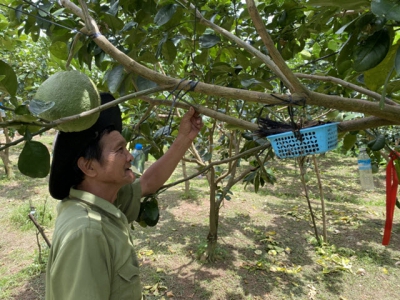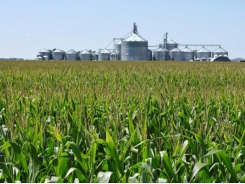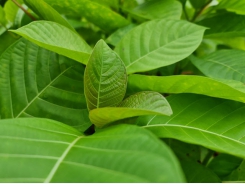Plant protection - a new stage

Facilities that analyze fruit, vegetable quality and pests need new, accurate, regionally or internationally certified technological equipment.
Growing organic grapefruit combined with weaver ant farming in Dong Thap Photo: Le Hoang Vu.
In order to develop sustainable agriculture, the plant protection industry needs to grasp the pressing issues in production, forecast harmful organisms on key crops, at least in the short term. Facilities that do analysis on fruit, vegetable quality and pests need new, accurate, regionally or internationally certified technological equipment.
Technology application, integrated pest management
Currently, we are passive when pests emerge, such as cassava mosaic disease. Although the disease has been recorded in previous plant protection surveys, there is no continuous monitoring or little information from foreign countries where the epidemic is occurring, making it difficult to control the disease when it attacks Vietnam's cassava production industry.
This issue is raised to reconfirm the need to make a list of major pests, have measures to monitor and be ready to provide temporary solutions in the case of widespread pests.
In this regard, other countries apply information technology to support investigation, forecast and thus act timely. Rice is an important crop of our country, ranked 2nd or 3rd in export worldwide, however, the application of new technology is still lacking on pest management on rice.
Tra Vinh University has recently completed the project "IoT technology application with smart sensor system and smartphone-based application to improve water use efficiency in rice farming in the Cuu Long Delta” with funding from the World Bank (WB) in 3 provinces of Tra Vinh, Can Tho and An Giang.
The project will be further supported to develop other objectives such as pest and disease forecasting in rice and irrigation management. In the explosive era of information technology, for Vietnam, a country having rice as the main food crop, applying GIS system to manage agriculture in general and manage the rice pests and diseases in particular is a necessary and urgent task.
International cooperation, taking shortcuts
Regarding international cooperation, Vietnam has taken a shortcut to catch up with new technologies: Applying molecular biology techniques to research plant pathogens, proposing effective solutions to prevent harmful organisms effectively and sustainably; also developed and applied IPM on many main crops; coordinated with FAO to implement activities under the SRI program to prevent fall armyworm, cassava mosaic disease, bamboo locust; carried out the Cooperation Program with China on migratory rice pest surveillance for the period 2016 - 2020.
The plant protection industry is also deeply involved in promoting market opening, completing procedures to remove technical barriers and exporting Vietnamese agricultural products to many countries around the world, including fastidious markets. International cooperation and market opening for Vietnamese agricultural products will contribute to the growth of agricultural exports in general and fresh fruits in particular.
Development must be more sustainable
The plant protection industry still has shortcomings while organizing the execution of key tasks assigned by the Ministry to serve sustainable agricultural production.
Research on plant protection:
The application of new techniques and technologies has brought accurate and fast results in pests diagnosis and detection, such as viruses and new harmful organisms, and proposed effective and timely prevention procedures based on the studies on aspects related to pests.
However, many pests still continue to arise and cause harm, appear continuously and are difficult to stop, possibly due to the complexity of harmful organisms in terms of ecological and biological characteristics, the impact of climate change or the lack of basis to properly and successfully develop the prevention process.
Moreover, the current pest investigation results are only scattered in topics and projects with research content to determine the composition, lacking general synthesis and prompt recommendations on the risk of occurrence, measures to reduce the risk and damage of the organisms.
Work on plant protection:
At present, many localities still lack unity in organization and direction, so the implementation of IPM application activities in production is generally scattered, fanned out and lacks coordination between the Agricultural Extension and Plant Protection units; results are slow to be replicated.
The work on market opening still has many obstacles and difficulties because countries are increasingly strict to protect domestic agricultural production. Meanwhile, Vietnam lacks detailed studies on harmful organisms’ treatments according to the market requirements of importing countries, which directly competes with Vietnamese agricultural products.
The management of pesticides is increasingly strict and well controlled at all stages. However, the coordination between specialized agencies from the central to local levels is not clear and strict, therefore pesticide management has not had its efficiency promoted at the stages of testing, trading and using.
Some suggestions
On the research:
There exists a need for new studies on plant protection in order to find solutions to manage agricultural crops’ pests in the context of climate change.
Assessments are required on the impact of climate change regarding pests outbreak, the efficiency of plant protection measures which are in current use, the change in resistance of pest-resistant crop varieties, and the development and research on harmful organisms.
On the development and application of plant protection biotechnology:
Continue to study microorganisms, beneficial agents and “natural enemy” parasites.
Research and develop technology for large biomass production and transfer directly or cooperate with agro-pharmaceutical companies for production and application in the mentioned programs and for agricultural production in general.
About the nation’s database:
Conserve the national microbial gene fund, the national standard sample museum, including harmful and beneficial microorganisms.
Establish national databases on microbial resources, especially pests, weeds and other species.
Regarding information and communication:
Develop a database and share with information and data sources of Departments in the MARD, other Ministries and Sectors on agriculture and plant protection. Customers, including farmers, can easily search for knowledge, experience, and information on content related to the activities of the plant protection industry.
Apply information technology in plant protection management
The plant protection industry needs to focus on implementing the following contents:
Apply information technology (IT), internet of things (IoT), remote sensing (RS) technology, and geographic information system (GIS) to apply in collecting information on plant pests, designing software to forecast and estimate pest occurrence.
Apply climate-smart agriculture (CSA) model based on large sample fields, irrigation management, efficient use of fertilizers, use of slow-release fertilizers, organic and microbial fertilizers, biological and botanical pesticides, apply new technologies and techniques in crop production.
Related news
Tools

Phối trộn thức ăn chăn nuôi

Pha dung dịch thủy canh

Định mức cho tôm ăn

Phối trộn phân bón NPK

Xác định tỷ lệ tôm sống

Chuyển đổi đơn vị phân bón

Xác định công suất sục khí

Chuyển đổi đơn vị tôm

Tính diện tích nhà kính

Tính thể tích ao









 Towards the goal of being…
Towards the goal of being…  Neolamarckia Cadamba becomesTuyen Quang's potential…
Neolamarckia Cadamba becomesTuyen Quang's potential…